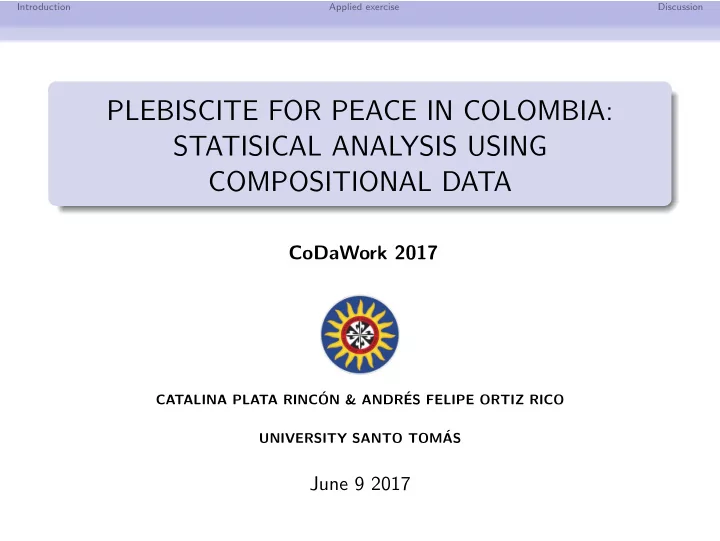

Introduction Applied exercise Discussion PLEBISCITE FOR PEACE IN COLOMBIA: STATISICAL ANALYSIS USING COMPOSITIONAL DATA CoDaWork 2017 CATALINA PLATA RINC´ ON & ANDR´ ES FELIPE ORTIZ RICO UNIVERSITY SANTO TOM´ AS June 9 2017
Introduction Applied exercise Discussion Introduction
Introduction Applied exercise Discussion Introduction Motivation: The similar behavior observed at the geographical level bet- ween the three electoral processes was the main motivation for the deve- lopment of this exercise. Figura 1: Geographical comparision
Introduction Applied exercise Discussion Variables used in the analysis Description of the variables used through the exercise:
Introduction Applied exercise Discussion Descriptive analysis: First round
Introduction Applied exercise Discussion Descriptive analysis: First round
Introduction Applied exercise Discussion Descriptive analysis: Second round & Plebiscite Figura 2: Second round and plebiscite
Introduction Applied exercise Discussion Techniques used: Linear model that predicts the result of the plebiscite Cluster analysis for plebiscite results Discriminant analysis for the results of the plebiscite
Introduction Applied exercise Discussion Model: The model equation in the simplex is: Y i = a ⊕ X 1 i ⊙ B 1 ⊕ X 2 i ⊙ B 2 ⊕ x 3 i ⊙ b 3 ⊕ x 4 i ⊙ b 4 ⊕ x 5 i ⊙ b 5 ⊕ ε i (1) In the real space, the equation of the model is: ilr ( Y i ) = ilr ( a ) + ilr ( X 1 i ) B 1 + ilr ( X 2 i ) B 2 + x 3 i b 3 + x 4 i b 4 + x 5 i b 5 + ε i (2) X 1 i : Composition of the first presidential round X 2 i : Composition of the second presidential round Y i : Composition of the plebiscite x 3 i : Population projected to the 2014 x 4 i : Voters potential in 2014 x 5 i Unsatisfied needs index 2008
Introduction Applied exercise Discussion Model: Graphical display of the result of the model adjustment to the data: Figura 3: Model adjustment vs Observed data
Introduction Applied exercise Discussion Model: Geographical comparison at the departmental level of the original results versus those obtained with the model. Figura 4: Geographical comparison of maps at departmental level: observed vs model
Introduction Applied exercise Discussion Model: The following table gives a global look to the results: The model indicate although with a small difference that the winning re- sult was the NO, a result that coincides with the observed results of the plebiscite, although as observed in the geographical comparison, there are 3 departments in which the model does not coincide with the reality.
Introduction Applied exercise Discussion Cluster: To determine each municipality or department to which cluster belonged (Yes-No), the information that was taken into account were only the com- positions referring to the 2 presidential rounds , later, the individuals were coloured considering the clasiffication made by the cluster.
Introduction Applied exercise Discussion Cluster: The result is shown below: Figura 5: Ternary diagram at the departmental level with the adjustment by the cluster
Introduction Applied exercise Discussion Cluster: Geographical comparison at the municipal level of the original results com- pared to those obtained with the cluster. Figura 6: Geographical comparison at municipal level: observed vs cluster
Introduction Applied exercise Discussion Cluster: Geographical comparison at the departmental level of the original results compared to those obtained with the cluster. Figura 7: Geographical comparison at departmental level: observed vs cluster
Introduction Applied exercise Discussion Cluster: The table below shows the percentage of successes of this method at the municipal level and at the departmental level: The two exercises at both the departmental and municipal level have very good results since in both cases the percentage of success is above 80 %.
Introduction Applied exercise Discussion Discriminant analysis: For this exercise, all available variables were used and the grouping variable was a dummy that indicated which outcome had been the winner for each municipality or department. (Yes - No)
Introduction Applied exercise Discussion Discriminant analysis: It is important to notice that even though is clear that are more red in- dividuals (YES), it doesn’t mean that this was the winner result. The demographic density of the population of each department has to be take into account. Figura 8: Ternary diagram at the departmental level with the adjustment by the discriminant analysis
Introduction Applied exercise Discussion Discriminant analysis: Geographical comparison at the municipal level of the original results com- pared to those obtained with discriminant analysis. Figura 9: Geographical comparison at municipal level: observed vs. discriminant
Introduction Applied exercise Discussion Discriminant analysis: Geographical comparison at the departmental level of the original results compared to those obtained with discriminant analysis. Figura 10: Geographical comparison at departmental level: observed vs. discriminant
Introduction Applied exercise Discussion Discriminant analysis: The table below shows the percentage of successes of this method at the municipal level and at the departmental level: The results at both the departmental and municipal level have very good results since in both cases the percentage of success is above 80 %; At least at the departmental level this method is better than the cluster, but it is important to remember that this exercise unlike the cluster, makes use of the results observed in the plebiscite.
Introduction Applied exercise Discussion Conclusions: The results of the three exercises applied in this case (the model, the cluster and the discriminant analysis) allow to highlight the great benefits and capacities of the techniques for CoDa. Although the objective of this exercise was not to find the best fit to the results of the electoral process, it should be pointed out that, with the variables used as the basis for the analysis, a good approximation is achieved to the real data.
Introduction Applied exercise Discussion ¡ Thanks !
Recommend
More recommend